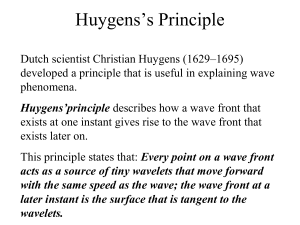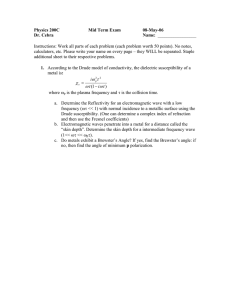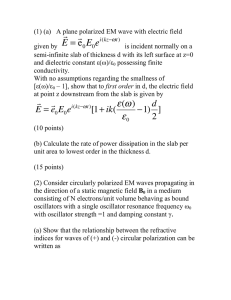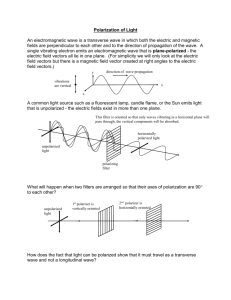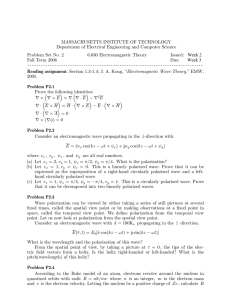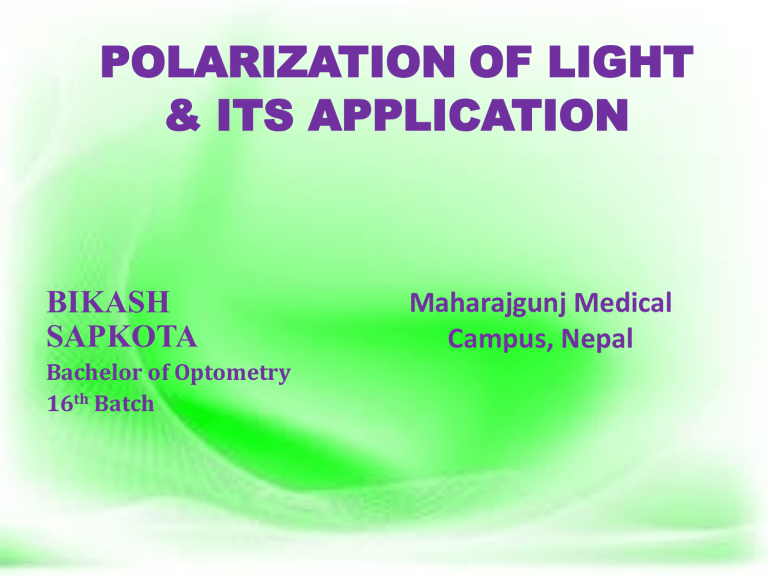
POLARIZATION OF LIGHT & ITS APPLICATION BIKASH SAPKOTA Bachelor of Optometry 16th Batch Maharajgunj Medical Campus, Nepal PRESENTATION LAYOUT Concept of Polarization Types of Polarization Methods of achieving Polarization Applications of Polarization ORDINARY LIGHT Electromagnetic wave Electric field E and magnetic field B are: oPerpendicular to each other oIn phase oAlso perpendicular to the direction of propagation Electric field vector Em wave Magnetic field vector ORDINARY LIGHT Unpolarized Light oContains large no.of atoms producing waves with particular orientation of electric vector E oResultant wave:unpolarized wave:superposition of waves vibrating in all possible directions POLARIZATION Transforming unpolarized light into polarized light Restriction of electric field vector E in a particular plane so that vibration occurs in a single plane Characteristic of transverse wave Longitudinal waves can’t be polarized; direction of their oscillation is along the direction of propagation . Polarization Plane of vibration A plane including the direction of light propagation and the direction of electric field Plane of polarization The plane perpendicular to the plane of vibration Why only electric field vector is considered in polarization and not magnetic field vector? Maxwell’s Equation E=c × B 8 c is velocity of light(c=3 × 10 m/s),very large value E>>>B i.e. Em wave is predominantly an electric wave To change any characteristics of Em wave, including polarization,E should be affected TYPES OF POLARIZATION 1. Linear Polarization 2. Circular Polarization 3. Elliptical Polarization LINEAR POLARIZATION Plane polarized wave Electric field vector oscillates along a straight line in one plane Resultant wave is linear in vertical plane Resultant wave is linear in 450 plane Superposition of plane polarized wave Two plane polarized waves are added according to the rules of vector addition Results in a linear,elliptical or circular polarized wave depending on the amplitude and the phase shift between two waves CIRCULAR POLARIZATION Consists of two perpendicular plane Em waves with equal amplitude and 900 phase difference Plane of oscillation rotates around the propagation axis May be right circularly polarized(clockwise) or left circularly polarized(counterclockwise) . Blue wave is resultant circular polarized wave . Superposition of oppositely polarized waves results in to plane polarized wave ELLIPTICAL POLARIZATION Consists of two perpendicular waves of unequal amplitude that differ in phase by 900 The tip of the resultant electric field vector describes an ellipse in any fixed plane intersecting and normal to the direction of propagation Circular and linear polarization:special cases of elliptical polarization Blue wave is resultant elliptical polarized wave Green wave is resultant elliptical polarized wave METHODS OF ACHIEVING POLARIZATION 1. 2. 3. 4. Reflection Scattering Dichroism Birefringence POLARIZATION BY REFLECTION Unpolarized light can undergo polarization by reflection off of non metallic surfaces like snow, glass Incident angle is such that angle between reflected and refracted ray is 900 Such incident angle is k/a polarizing angle or Brewster’s angle Reflected ray is linearly polarized parallel to the reflecting surface BREWSTER’S LAW When light is incident at polarizing angle: The tangent of polarizing angle=Refractive index of material i.e, tan θ= µ For Sapphire, µ=1.77 So, θ=tan-1(1.77)=60.5350 If the angle of incidence is not exactly the Brewster’s angle the reflected ray will only be partially polarized Interesting, right? This is just a sneak preview of the full presentation. We hope you like it! To see the rest of it, just click here to view it in full on PowerShow.com. Then, if you’d like, you can also log in to PowerShow.com to download the entire presentation for free.

![Hints to Assignment #12 -- 8.022 [1] Lorentz invariance and waves](http://s2.studylib.net/store/data/013604158_1-7e1df448685f7171dc85ce54d29f68de-300x300.png)

